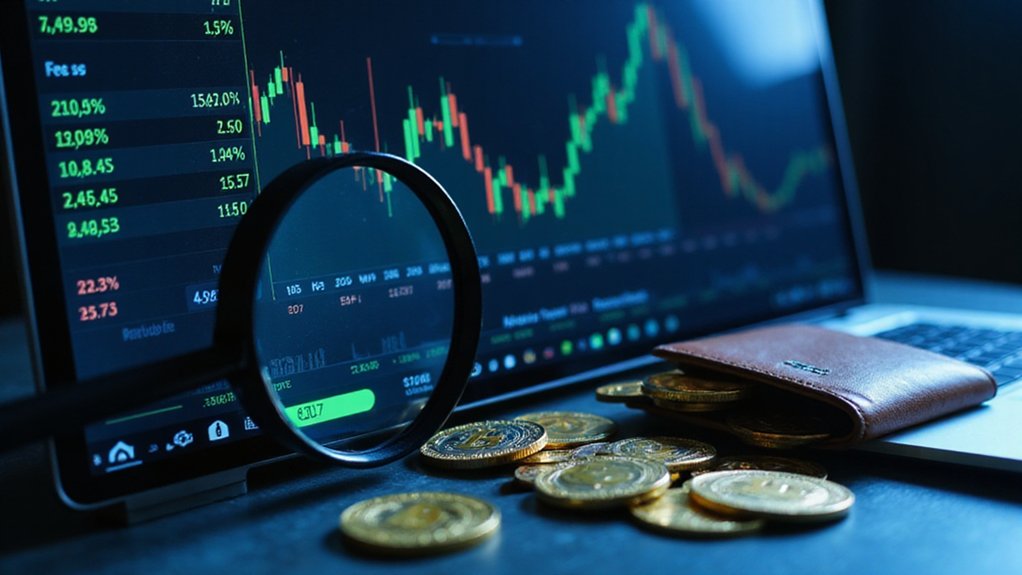Robinhood emerges as the fee champion with its zero-commission cryptocurrency trading, though this apparent largesse masks potential spread markups. Binance.US follows with competitive rates of 0.10% (sliding to 0.02% for volume traders), while Kraken’s tiered structure bottoms at 0.00% for makers. Most platforms offer free ACH deposits, but withdrawal costs vary dramatically by asset and method. The true calculus of exchange value extends beyond headline rates to security protocols, asset selection, and overall fee ecosystem.

The byzantine landscape of cryptocurrency exchanges—with their labyrinthine fee structures and opaque pricing models—presents a formidable challenge for investors seeking to maximize returns in an already volatile market.
While crypto enthusiasts often fixate on asset performance, the seemingly minuscule transaction costs can, over time, devour profits with the ruthless efficiency of compound interest working in reverse.
Robinhood emerges as the clear frontrunner in the low-fee arena, offering the holy grail of cryptocurrency trading: zero-fee transactions.
For cost-conscious crypto traders, Robinhood’s zero-fee structure represents an oasis of profitability in a desert of transaction costs.
This commission-free structure (though one might reasonably question how they monetize this apparent largesse¹) represents an unparalleled advantage for cost-conscious traders.
Robinhood’s user-friendly app makes trading accessible to both beginners and experienced investors looking to diversify into cryptocurrencies.
Binance.US follows with competitive standard rates of 0.10% for both buying and selling—a modest toll that diminishes further to a mere 0.02% for volume traders who move substantial assets through the platform.
Kraken presents a sliding scale of fees that rewards market makers with rates starting at 0.00% while charging takers between 0.10% and 0.40%. Kraken’s affordability is enhanced by its low minimum deposit of $10, making it accessible to novice investors.
High-volume traders can achieve significant reductions, potentially paying nothing as makers while takers see fees bottom out at 0.10%.
By contrast, Gemini and Bitstamp impose steeper costs, with the latter charging a relatively exorbitant 0.50% standard rate.
Beyond the headline transaction fees, prudent investors must consider the broader fee ecosystem.
Most major exchanges—Kraken, Binance.US, Gemini, and Bitstamp—offer free ACH deposits, though withdrawal costs vary considerably by asset and method.
The seemingly trivial $5 withdrawal fee from eToro appears straightforward but lacks the nuanced asset-specific approach of its competitors.
Security considerations inevitably complicate this calculus.
Kraken’s robust security protocols come without FDIC/SIPC insurance, while Gemini emphasizes both security and regulatory compliance.
Market access presents another variable—Kraken’s impressive roster of over 300 cryptocurrencies dwarfs Robinhood‘s limited selection of major tokens.
The discriminating trader might reasonably conclude that the “lowest fee” exchange must be evaluated not merely on transaction costs, but on this constellation of factors that collectively determine true value.
¹Often through payment for order flow and spread markups.
Frequently Asked Questions
What Security Measures Do Low-Fee Exchanges Implement?
Low-fee crypto exchanges deploy robust security protocols despite their cost-efficiency.
These typically include industrial-grade encryption, mandatory two-factor authentication, and cold storage solutions that keep the majority of assets offline (where hackers can’t reach them).
Regular security audits, strict KYC/AML compliance procedures, and multi-signature wallet technologies further fortify these platforms.
While budget-conscious traders might gravitate toward fee savings, these exchanges recognize that security compromises would prove catastrophically counterproductive to their business model.
How Do Exchange Fees Affect Tax Reporting?
Exchange fees fundamentally alter one’s tax liability by modifying cost basis calculations—those seemingly insignificant transaction costs actually serve as valuable tax adjusters.
When purchasing crypto, fees increase acquisition costs; when selling, they reduce proceeds.
Prudent traders meticulously document these fees, as proper accounting can substantially reduce capital gains exposure or amplify deductible losses.
The IRS, unsurprisingly, expects complete transaction reporting, including these oft-overlooked fee components that can make meaningful differences in annual tax obligations.
Can I Stake My Crypto on Low-Fee Exchanges?
Many low-fee exchanges offer staking capabilities with varying terms.
Kraken stands out with flexible unstaking without penalties and competitive rewards up to 17%.
Some platforms like ByBit offer no-fee staking for select cryptocurrencies, while others (Binance, Coinbase) take substantial cuts of 25-35% from rewards.
The staking landscape presents a curious paradox: “low-fee” exchanges aren’t necessarily low-fee for staking services.
Careful comparison of both trading and staking fee structures remains essential for optimization.
Do Fee Structures Change During Market Volatility?
Crypto exchange fee structures indeed fluctuate during market volatility.
Exchanges typically increase fees during turbulent periods to mitigate elevated risk and operational demands, while reducing them in calmer markets.
This volatility-responsive pricing manifests in widened bid-ask spreads and higher network fees due to blockchain congestion.
Dynamic fee models automatically adjust based on market conditions, while liquidity levels serve as a counterbalancing force—exchanges with robust liquidity generally maintain more stable fee structures, even amidst market chaos.
Are There Minimum Deposit Requirements for Low-Fee Exchanges?
Low-fee exchanges exhibit varying deposit requirements across the spectrum.
Kraken mandates a modest $10 entry point, while platforms like Fusion Markets eliminate minimums entirely for crypto trading.
eToro’s threshold fluctuates geographically (often starting at $50), and FP Markets similarly requires a $50 initial commitment.
Decentralized exchanges—often champions of accessibility—frequently operate without deposit floors, though the technical barriers to entry may constitute their own form of gatekeeping for novice participants.








